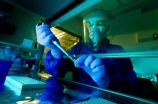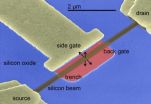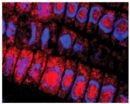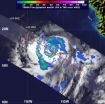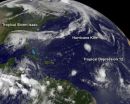(Press-News.org) This release is available in German.
The analyses of an international team of researchers led by Svante Pääbo of the Max Planck Institute for Evolutionary Anthropology in Leipzig, Germany, show that the genetic variation of Denisovans was extremely low, suggesting that although they were present in large parts of Asia, their population was never large for long periods of time. In addition, a comprehensive list documents the genetic changes that set apart modern humans from their archaic relatives. Some of these changes concern genes that are associated with brain function or nervous system development.
In 2010 Svante Pääbo and his colleagues sequenced DNA that they isolated from a finger bone fragment discovered in the Denisova Cave in southern Siberia. They found that it belonged to a young girl of a previously unknown group of archaic humans that they called "Denisovans". Thanks to a novel technique which splits the DNA double helix so that each of its two strands can be used for sequencing, the team was able to sequence every position in the Denisovan genome about 30 times over. The thus generated genome sequence shows a quality similar to genomes that have been determined from present-day humans.
In a new study, which is published in this week's issue of the journal Science, Svante Pääbo and his colleagues compare the Denisovan genome with those of the Neandertals and eleven modern humans from around the world. Their findings confirm a previous study according to which modern populations from the islands of southeastern Asia share genes with the Denisovans. In addition, the genomes of people from East Asia, and South America include slightly more genes from Neandertals than those of people in Europe: "The excess archaic material in East Asia is more closely related to Neandertals than to Denisovans, so we estimate that the proportion of Neandertal ancestry in Europe is lower than in eastern Asia", the Leipzig researchers report.
"This is an extinct genome sequence of unprecedented accuracy", says Matthias Meyer, the lead author of the study. "For most of the genome we can even determine the differences between the two sets of chromosomes that the Denisovan girl inherited from her mother and father". From this the researchers can tell that genetic variation of the Denisovans was lower than in present-day humans. This is likely due to that an initially small Denisovan population that grew quickly while spreading over a wide geographic range. "If future research of the Neandertal genome shows that their population size changed over time in similar ways, it may well be that a single population expanding out of Africa gave rise to both the Denisovans and the Neandertals", says Svante Pääbo, who led the study.
The researchers furthermore generated a list of about 100,000 recent changes in the human genome that occurred after the split from the Denisovans. Some of these changes affect genes that are associated with brain function and nervous system development. Others possibly affect the skin, the eye and dental morphology. "This research will help determining how it was that modern human populations came to expand dramatically in size as well as cultural complexity while archaic humans eventually dwindled in numbers and became physically extinct", says Svante Pääbo.
Earlier this year, the Leipzig researchers had already made the entire Denisovan genome sequence available to the broader public by publishing it online.
INFORMATION:
This project has been funded by the Max Planck Society. The finger bone was discovered by Anatoly Derevianko and Michail Shunkov of the Russian Academy of Sciences in 2008 during their excavations at Denisova Cave, a unique archaeological site which contains cultural layers indicating that human occupation at the site started already 280,000 years ago. The finger bone was found in a layer which has been dated to between 50,000 and 30,000 years ago.
Original publication:
Matthias Meyer, Martin Kircher, Marie-Theres Gansauge, Heng Li, Fernando Racimo, Swapan Mallick, Joshua G. Schraiber, Flora Jay, Kay Prüfer, Cesare de Filippo, Peter H. Sudmant, Can Alkan, Qiaomei Fu, Ron Do, Nadin Rohland, Arti Tandon, Michael Siebauer, Richard E. Green, Katarzyna Bryc, Adrian W. Briggs, Udo Stenzel, JesseDabney, Jay Shendure, Jacob Kitzman, Michael F. Hammer, Michael V. Shunkov, Anatoli P. Derevianko, Nick Patterson, Aida M. Andrés, Evan E. Eichler, Montgomery Slatkin, David Reich, Janet Kelso, Svante Pääbo
A high coverage genome sequence from an archaic Denisovan individual
Science, August 30, 2012
Ancient genome reveals its secrets
Max Planck researchers describe Denisovan genome, illuminating the relationships between Denisovans and present-day humans
2012-08-31
ELSE PRESS RELEASES FROM THIS DATE:
Microbes help hyenas communicate via scent
2012-08-31
EAST LANSING, Mich. — Bacteria in hyenas' scent glands may be the key controllers of communication.
The results, featured in the current issue of Scientific Reports, show a clear relationship between the diversity of hyena clans and the distinct microbial communities that reside in their scent glands, said Kevin Theis, the paper's lead author and Michigan State University postdoctoral researcher.
"A critical component of every animal's behavioral repertoire is an effective communication system," said Theis, who co-authored the study with Kay Holekamp, MSU zoologist. ...
Moving toward regeneration
2012-08-31
KANSAS CITY, MO—The skin, the blood, and the lining of the gut—adult stem cells replenish them daily. But stem cells really show off their healing powers in planarians, humble flatworms fabled for their ability to rebuild any missing body part. Just how adult stem cells build the right tissues at the right times and places has remained largely unanswered.
Now, in a study published in an upcoming issue of Development, researchers at the Stowers Institute for Medical Research describe a novel system that allowed them to track stem cells in the flatworm Schmidtea mediterranea. ...
Health reform: How community health centers could offer better access to subspecialty care
2012-08-31
FINDINGS:
The Affordable Care Act will fund more community health centers, making primary care more accessible to the underserved. But this may not necessarily lead to better access to subspecialty care.
In a new study, researchers from the David Geffen School of Medicine and Robert Wood Johnson Foundation Clinical Scholars program at UCLA and colleagues investigated the ways in which community health centers access subspecialty care. They identified six major models and determined which of those six offered the best access:
Tin cup ...
Researchers measure photonic interactions at the atomic level
2012-08-31
DURHAM, N.C. -- By measuring the unique properties of light on the scale of a single atom, researchers from Duke University and Imperial College, London, believe that they have characterized the limits of metal's ability in devices that enhance light.
This field is known as plasmonics because scientists are trying to take advantage of plasmons, electrons that have been "excited" by light in a phenomenon that produces electromagnetic field enhancement. The enhancement achieved by metals at the nanoscale is significantly higher than that achievable with any other material.
Until ...
'Nanoresonators' might improve cell phone performance
2012-08-31
"There is not enough radio spectrum to account for everybody's handheld portable device," said Jeffrey Rhoads, an associate professor of mechanical engineering at Purdue University.
The overcrowding results in dropped calls, busy signals, degraded call quality and slower downloads. To counter the problem, industry is trying to build systems that operate with more sharply defined channels so that more of them can fit within the available bandwidth.
"To do that you need more precise filters for cell phones and other radio devices, systems that reject noise and allow signals ...
Discovery may help protect crops from stressors
2012-08-31
VIDEO:
Scientists at the Salk Institute for Biological Studies have discovered a key genetic switch by which plants control their response to ethylene gas, a natural plant hormone best known for...
Click here for more information.
LA JOLLA, CA----Scientists at the Salk Institute for Biological Studies have discovered a key genetic switch by which plants control their response to ethylene gas, a natural plant hormone best known for its ability to ripen fruit, but which, under ...
Biophysicists unravel secrets of genetic switch
2012-08-31
When an invading bacterium or virus starts rummaging through the contents of a cell nucleus, using proteins like tiny hands to rearrange the host's DNA strands, it can alter the host's biological course. The invading proteins use specific binding, firmly grabbing onto particular sequences of DNA, to bend, kink and twist the DNA strands. The invaders also use non-specific binding to grasp any part of a DNA strand, but these seemingly random bonds are weak.
Emory University biophysicists have experimentally demonstrated, for the fist time, how the nonspecific binding of ...
NASA spotted hot towers in Ileana that indicated its increase to hurricane status
2012-08-31
Hot Towers are towering clouds that emit a tremendous amount of latent heat (thus, called "hot"). NASA research indicates that whenever a hot tower is spotted, a tropical cyclone will likely intensify. Less than 14 hours after the TRMM satellite captured an image of Ileana's rainfall and cloud heights, Ileana strengthened into a hurricane on Aug. 29.
NASA's Tropical Rainfall Measuring Mission (TRMM) satellite captured a view of Ileana's rainfall rates on Aug. 29 at 2:17 a.m. EDT and saw the heaviest rainfall rates, near 50 mm (2.0 inches) per hour in a band of thunderstorms ...
NASA sees Tropical Storm Tembin make landfall in South Korea
2012-08-31
Tropical Storm Tembin made landfall in the in southwestern South Korea and NASA's Aqua satellite captured the extent of the storm's elongated cloud cover, revealing the effect of wind shear on the storm.
Tembin moved through the Myeongnyang Strait and made landfall on Aug. 30, 2012 at 0000 UTC (Aug. 29 at 8 p.m. EDT) in the southwestern tip of South Korea.
NASA's Aqua satellite's Moderate Resolution Imaging Spectroradiometer (MODIS) instrument captured a visible, true-color image of Tropical Storm Tembin around the time of landfall in southwestern South Korea. The image ...
NASA spies fifth Atlantic hurricane and twelfth tropical depression
2012-08-31
Tropical Storm Kirk intensified into a hurricane today, Aug. 30, while another tropical depression was born. Satellite imagery revealed Hurricane Kirk and newborn Tropical Depression 12 romping through the central Atlantic Ocean today, while Tropical Storm Isaac continues to drench the U.S. Gulf coast and Mississippi Valley. Kirk became the Atlantic Ocean season's fifth hurricane today, Aug. 30.
On Aug. 30 at 7:45 a.m. EDT, a visible image from NOAA's GOES-13 satellite captured all three tropical cyclones in a panoramic shot of the Atlantic Ocean basin. The visible image ...
LAST 30 PRESS RELEASES:
Normalizing blood sugar can halve heart attack risk
Lowering blood sugar cuts heart attack risk in people with prediabetes
Study links genetic variants to risk of blinding eye disease in premature infants
Non-opioid ‘pain sponge’ therapy halts cartilage degeneration and relieves chronic pain
AI can pick up cultural values by mimicking how kids learn
China’s ecological redlines offer fast track to 30 x 30 global conservation goal
Invisible indoor threats: emerging household contaminants and their growing risks to human health
Adding antibody treatment to chemo boosts outcomes for children with rare cancer
Germline pathogenic variants among women without a history of breast cancer
Tanning beds triple melanoma risk, potentially causing broad DNA damage
Unique bond identified as key to viral infection speed
Indoor tanning makes youthful skin much older on a genetic level
Mouse model sheds new light on the causes and potential solutions to human GI problems linked to muscular dystrophy
The Journal of Nuclear Medicine ahead-of-print tip sheet: December 12, 2025
Smarter tools for peering into the microscopic world
Applications open for funding to conduct research in the Kinsey Institute archives
Global measure underestimates the severity of food insecurity
Child survivors of critical illness are missing out on timely follow up care
Risk-based vs annual breast cancer screening / the WISDOM randomized clinical trial
University of Toronto launches Electric Vehicle Innovation Ontario to accelerate advanced EV technologies and build Canada’s innovation advantage
Early relapse predicts poor outcomes in aggressive blood cancer
American College of Lifestyle Medicine applauds two CMS models aligned with lifestyle medicine practice and reimbursement
Clinical trial finds cannabis use not a barrier to quitting nicotine vaping
Supplemental nutrition assistance program policies and food insecurity
Switching immune cells to “night mode” could limit damage after a heart attack, study suggests
URI-based Global RIghts Project report spotlights continued troubling trends in worldwide inhumane treatment
Neutrophils are less aggressive at night, explaining why nighttime heart attacks cause less damage than daytime events
Menopausal hormone therapy may not pose breast cancer risk for women with BRCA mutations
Mobile health tool may improve quality of life for adolescent and young adult breast cancer survivors
Acupuncture may help improve perceived breast cancer-related cognitive difficulties over usual care
[Press-News.org] Ancient genome reveals its secretsMax Planck researchers describe Denisovan genome, illuminating the relationships between Denisovans and present-day humans
